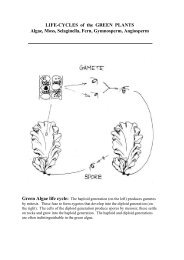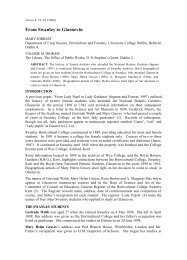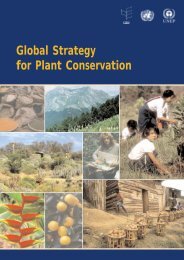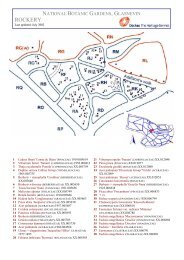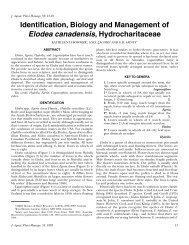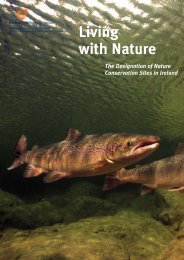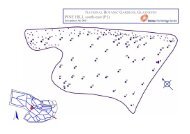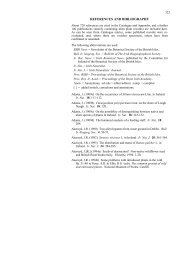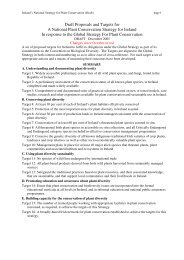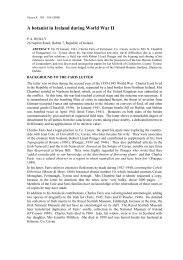Lichens of Lambay Island - National Botanic Gardens
Lichens of Lambay Island - National Botanic Gardens
Lichens of Lambay Island - National Botanic Gardens
You also want an ePaper? Increase the reach of your titles
YUMPU automatically turns print PDFs into web optimized ePapers that Google loves.
Glasra 4: 1–6 (2000)<br />
<strong>Lichens</strong> <strong>of</strong> <strong>Lambay</strong> <strong>Island</strong><br />
M. R. D. SEAWARD<br />
Department <strong>of</strong> Environmental Science, University <strong>of</strong> Bradford, Bradford BD7 1DP, UK.<br />
D. H. S. RICHARDSON<br />
Faculty <strong>of</strong> Science, Saint Mary’s University, Halifax, Nova Scotia B3H 3C3, Canada.<br />
INTRODUCTION<br />
Prior to our visit in May 1987, information on the lichen flora <strong>of</strong> <strong>Lambay</strong> was sketchy,<br />
being based on a few records made by Isaac Carroll (1828-1880), mentioned by Knowles<br />
(1929), and a short list made by David McArdle (1849-1934) which appeared in the<br />
previously published survey <strong>of</strong> the island (McArdle, 1907). Few details survive <strong>of</strong> the<br />
visit made by Carroll, a very competent lichenologist, but herbarium packets in the Natural<br />
History Museum, London are dated June 1863 and several <strong>of</strong> his records appear in<br />
Leighton (1879) and Smith (1918, 1926). McArdle’s list contains 17 taxa (14 species and 3<br />
varieties) recorded by him during a brief visit made in November 1906, but several <strong>of</strong> these<br />
lichens are doubtful or difficult to interpret in the absence <strong>of</strong> supporting herbarium<br />
material. In the light <strong>of</strong> the above, a baseline survey for comparative studies is not<br />
feasible: had Matilda Knowles (1864-1933) been able to visit the island, no doubt she<br />
would have provided a detailed study <strong>of</strong> its lichen flora for this purpose, similar to that<br />
which she undertook on the nearby peninsula <strong>of</strong> Howth (Knowles, 1913).<br />
The tides dictated the times <strong>of</strong> arrival and departure <strong>of</strong> our sailing-boat to <strong>Lambay</strong> and<br />
in consequence we were only able to spend a bare three hours there. We were<br />
accompanied by Peter James and Howard Fox who remained in the harbour area; the<br />
authors ranged more extensively over the island, paying particular attention to maritime<br />
zones, exposed rocks, man-made structures (especially those <strong>of</strong> the harbour, castle and<br />
chapel), and trees and shrubs. We had little opportunity to study terricolous habitats,<br />
substrata <strong>of</strong> which according to McArdle (1907) supported several Cladonia species as<br />
yet unconfirmed. In all, the group recorded 129 species, which although not a definitive<br />
list very considerably extends the knowledge <strong>of</strong> its lichen flora.<br />
<strong>Lambay</strong> <strong>Island</strong> lies 4 km from the coast <strong>of</strong> Co. Dublin and is formed mainly <strong>of</strong> volcanic<br />
rocks; it covers an area <strong>of</strong> c. 250 hectares and its highest point is 127 m above sea-level.<br />
Lichenologically the island has much to <strong>of</strong>fer in terms <strong>of</strong> the biodiversity <strong>of</strong> saxicolous<br />
habitats; there is also a reasonable number <strong>of</strong> mature trees, particularly around the Castle,<br />
and other habitats supporting corticolous and lichenicolous species. However,<br />
terricolous species were poorly represented; this contrasts significantly with the<br />
description <strong>of</strong> the island portrayed in Hart (1883) and Praeger (1907b) who draw attention<br />
to the fact that much <strong>of</strong> its surface was occupied by Calluna and Erica cinerea, and<br />
supported by McArdle (1907) in terms <strong>of</strong> the lichens he recorded. Praeger (1934) draws<br />
attention to the influence <strong>of</strong> large colonies <strong>of</strong> breeding herring gulls; from our<br />
observations it is apparent that this influence continues, and no doubt has greatly<br />
increased, particularly in respect <strong>of</strong> eutrophication, and consequently a representative<br />
heathland lichen flora may be close to extinction.<br />
Teloschistes flavicans, which Carroll recorded on <strong>Lambay</strong>, has not been seen here<br />
since the 19 th century and is no doubt extinct as it is in many other localities in the British<br />
Isles: this eye-catching bright orange species, formerly widespread on a variety <strong>of</strong><br />
substrata, is now very localized, occurring in south-west Ireland, west Wales and south-
2 M. R. D. Seaward & D. H. S. Richardson<br />
west England (Gilbert, 1998).<br />
For accounts <strong>of</strong> the geology and former natural history <strong>of</strong> <strong>Lambay</strong> see the papers<br />
contained in Praeger (1907a) and for a more detailed review <strong>of</strong> the topography, vegetation<br />
and bryophyte flora <strong>of</strong> <strong>Lambay</strong> see Synnott (1990).<br />
THE LICHENS<br />
The following list <strong>of</strong> 142 lichens and 1 lichenicolous fungus includes those taxa recorded<br />
by earlier workers, indicated by square brackets [ ], not observed during the 1987 visit.<br />
Additional records provided by P. W. James (in litt.) are indicated by PWJ, and new vicecounty<br />
(Dublin, H21) records (cf. Seaward 1984), subsequently included in Seaward (1994)<br />
are indicated by VCR. Substrata for the more recently recorded species are as follows: S<br />
= saxicolous (on rocks, walls and other artificial stone surfaces); C = corticolous (on trees<br />
and shrubs); T = terricolous (on soil). The nomenclature is according to Purvis et al.<br />
(1994) and voucher specimens for some taxa are to be found in the Natural History<br />
Museum, London (BM) and Herb. Seaward.<br />
Anaptychia runciniata (With.) J.R.Laundon S<br />
Anisomeridium biforme (Borrer) R.C.Harris C<br />
Arthonia impolita (H<strong>of</strong>fm.) Borrer (VCR) C<br />
Arthonia radiata (Pers.) Ach. C<br />
[Arthonia varians (Davies) Nyl. on Lecanora rupicola – Carroll, in Leighton (1879:<br />
426) and Knowles (1929: 383)]<br />
Aspicilia caesiocinerea (Nyl. ex. Zahlbr.) Arnold S<br />
Aspicilia calcarea (L.) Mudd S<br />
[Aspicilia cinerea (L.) Körber – in Knowles (1929: 286) and Smith (1918: 316)]<br />
Aspicilia contorta (H<strong>of</strong>fm.) Krempelh. S<br />
Aspicilia leprosescens (Sandst.) Havaas S<br />
Bacidia phacodes Körber (PWJ) C<br />
Bacidia rubella (H<strong>of</strong>fm.) A.Massal. (PWJ) C<br />
Buellia aethalea (Ach.) Th.Fr. S<br />
Buellia punctata (H<strong>of</strong>fm.) A.Massal. C<br />
Buellia stellulata (Taylor) Mudd S<br />
Buellia subdisciformis (Leighton) Jatta (PWJ) S<br />
Caloplaca citrina (H<strong>of</strong>fm.) Th.Fr. S<br />
Caloplaca crenularia (With.) J.R.Laundon S<br />
Caloplaca flavescens (Huds.) J.R.Laundon S<br />
Caloplaca flavovirescens (Wulfen) Dalla Torre & Sarnth. S<br />
Caloplaca holocarpa (H<strong>of</strong>fm.) Wade S<br />
Caloplaca marina (Wedd.) Zahlbr. ex Du Rietz S<br />
Caloplaca microthallina (Wedd.) Zahlbr. S<br />
Caloplaca saxicola (H<strong>of</strong>fm.) Nordin S<br />
Caloplaca thallincola (Wedd.) Du Rietz S<br />
Caloplaca verruculifera (Vainio) Zahlbr. S<br />
Candelariella aurella (H<strong>of</strong>fm.) Zahlbr. S<br />
Candelariella coralliza (Nyl.) H.Magn. S<br />
Candelariella medians (Nyl.) A.L.Sm. S<br />
Candelariella vitellina (H<strong>of</strong>fm.) Müll.Arg. S
LICHENS OF LAMBAY ISLAND 3<br />
Catillaria chalybeia (Borrer) A.Massal. S<br />
Catillaria lenticularis (Ach.) Th.Fr. S<br />
Chrysothrix candelaris (L.) J.R.Laundon C<br />
[Cladonia arbuscula (Wallr.) Flotow – as C. rangiferina var. sylvatica in McArdle<br />
(1907: 111)]<br />
[Cladonia gracilis (L.) Willd. – in McArdle (1907: 110) – possible, but probably C.<br />
furcata (Huds.) Schrader]<br />
[Cladonia pyxidata (L.) H<strong>of</strong>fm. – in McArdle (1907: 110) – possible, but probably<br />
another species]<br />
[Cladonia rangiferina (L.) Weber ex Wigg. – in McArdle (107: 111) – unlikely;<br />
possibly C. arbuscula, C. ciliata var. tenuis or C. rangiformis]<br />
Cladonia rangiformis H<strong>of</strong>fm. T<br />
[Cladonia stellaris (Opiz.) Pouzar & Vezda – as C. rangiferina var. alpestris in<br />
McArdle (1907: 111) and as C. alpestris in Knowles (1929: 309) – unlikely;<br />
possibly C. portentosa or another species - see under C. rangiferina above].<br />
Collema auriforme (With.) Coppins & J.R.Laundon S<br />
Collema tenax var. ceranoides (Borrer) Degel. T<br />
Diploicia canescens (Dickson) A.Massal. C, S<br />
Diplotomma alboatrum (H<strong>of</strong>fm.) Flotow S<br />
Diplotomma chlorophaeum (Hepp ex Leighton ) Szat. S<br />
Dirina massiliensis forma sorediata (Müll.Arg.) Tehler (VCR) S<br />
Enterographa crassa (DC.) Fée C<br />
Evernia prunastri (L.) Ach. C<br />
Fuscidea cyathoides (Ach.) V.Wirth & Vezda S<br />
[Graphis scripta (L.) Ach. – in McArdle (1907: 111)]<br />
Hyperphyscia adglutinata (Flörke) H.Mayrh<strong>of</strong>er & Poelt C<br />
[Hypogymnia physodes (L.) Nyl. – in McArdle (1907: 111)]<br />
Lecanactis premnea (Ach.) Arnold C<br />
Lecania cyrtella (Ach.) Th.Fr. (PWJ) C<br />
Lecania erysibe (Ach.) Mudd S<br />
Lecanora actophila Wedd. S<br />
Lecanora albescens (H<strong>of</strong>fm.) Branth & Rostrup S<br />
Lecanora campestris (Schaerer) Hue S<br />
Lecanora chlarotera Nyl. C<br />
Lecanora crenulata Hook. S<br />
Lecanora dispersa (L.) Sommerf. S<br />
Lecanora expallens Ach. C<br />
Lecanora fugiens Nyl. S<br />
Lecanora gangaleoides Nyl. S<br />
Lecanora helicopis (Wahlenb.) Ach. S<br />
Lecanora intricata (Ach.) Ach. S<br />
Lecanora muralis (Schreber) Rabenh. S<br />
Lecanora polytropa (H<strong>of</strong>fm.) Rabenh. S<br />
Lecanora rupicola (L.) Zahlbr. S
4 M. R. D. Seaward & D. H. S. Richardson<br />
Lecanora sulphurea (H<strong>of</strong>fm.) Ach. S<br />
Lecidea lithophila (Ach.) Ach. S<br />
Lecidella asema (Nyl.) Knoph & Hertel S<br />
Lecidella elaeochroma (Ach.) M.Choisy C<br />
Lecidella scabra (Taylor) Hertel & Leuckert S<br />
Lecidella stigmatea (Ach.) Hertel & Leuckert S<br />
Lepraria incana (L.) Ach. C, S<br />
Lepraria lobificans Nyl. (VCR) (PWJ) S<br />
Micarea prasina Fr. C<br />
Ochrolechia androgyna (H<strong>of</strong>fm.) Arnold C, S<br />
Ochrolechia parella (L.) A.Massal. S<br />
Opegrapha atra Pers. C<br />
Opegrapha rufescens Pers. (VCR) C<br />
Opegrapha vulgata (Ach.) Ach. C<br />
Parmelia caperata (L.) Ach. C<br />
Parmelia glabratula (Lamy) Nyl. C<br />
Parmelia perlata (Huds.) Ach. C<br />
Parmelia revoluta Flörke C<br />
[Parmelia saxatilis (L.) Ach. – in McArdle (1907: 111)]<br />
Parmelia subaurifera Nyl. C<br />
Parmelia subrudecta Nyl. C<br />
Parmelia sulcata Taylor C<br />
Parmelia verruculifera Nyl. (VCR) S<br />
[Peltigera canina (L.) Willd. – in McArdle (1907: 111) – probably P. membranacea]<br />
Peltigera lactucifolia (With.) J.R.Laundon (VCR) T<br />
Peltigera membrancea (Ach.) Nyl. (VCR) T<br />
Pertusaria amara (Ach.) Nyl. C<br />
Pertusaria corallina (L.) Arnold S<br />
Pertusaria pertusa (Weigel) Tuck. C<br />
Pertusaria pseudocorallina (Lilj.) Arnold S<br />
Phaeophyscia nigricans (Flörke) Moberg (VCR) S<br />
Phaeophyscia orbicularis (Necker) Moberg S<br />
Phlyctis argena (Sprengel) Flotow C<br />
Physcia adscendens (Fr.) H.Olivier C, S<br />
Physcia caesia (H<strong>of</strong>fm.) Fürnr. S<br />
Physcia tenella (Ach.) Müll.Arg. C<br />
Placynthiella icmalea (Ach.) Coppins & P.James C<br />
Placynthium nigrum (Huds.) Gray S<br />
Porina chlorotica (Ach.) Müll.Arg. S<br />
Porpidia tuberculosa (Sm.) Hertel & Knopf S<br />
Pyrenocollema halodytes (Nyl.) R.C.Harris S<br />
Pyrenula macrospora (Degel.) Coppins & P.James (VCR) C<br />
Pyrrhospora quernea (Dickson) Körber C<br />
[Ramalina calicaris (L.) Fr. – in McArdle (1907: 111) – probably another species]<br />
Ramalina canariensis Steiner C, S<br />
Ramalina farinacea (L.) Ach. C
LICHENS OF LAMBAY ISLAND 5<br />
Ramalina fastigiata (Pers.) Ach. C<br />
Ramalina fraxinea (L.) Ach. C<br />
Ramalina lacera (With.) J.R.Laundon (VCR) C<br />
Ramalina siliquosa (L.) Ach. S<br />
Ramalina subfarinacea (L.) Ach. S<br />
Rhizocarpon concentricum (Davies) Beltr. S<br />
Rhizocarpon geographicum (L.) D.C. S<br />
Rhizocarpon obscuratum (Ach.) A.Massal. S<br />
Rhizocarpon richardii (Nyl.) Zahlbr. S<br />
Rinodina gennarii Bagl. S<br />
Scoliciosporum umbrinum (Ach.) Arnold S<br />
[Sphaerophorus globosus (Huds.) Vainio – in McArdle (1907: 111)]<br />
[Teloschistes flavicans (Swartz) Norman – Carroll, in Leighton (1879: 131), Smith<br />
(1918: 191) and Knowles (1929: 252)]<br />
Tephromela atra (Huds.) Hafellner ex Kalb S<br />
Toninia aromatica (Sm.) A.Massal. S<br />
Trapelia involuta (Taylor) Hertel S<br />
Trapelia placodioides Coppins & P.James (VCR) (PWJ) S<br />
Trapeliopsis granulosa (H<strong>of</strong>fm.) Lumbsch C<br />
Verrucaria fusconigrescens Nyl. (VCR) S<br />
Verrucaria glaucina auct. S<br />
Verrucaria maura Wahlenb. S<br />
Verrucaria mucosa Wahlenb. S<br />
Verrucaria muralis Ach. S<br />
Verrucaria nigrescens Pers. S<br />
Verrucaria striatula Wahlenb. S<br />
Xanthoria calcicola Oxner S<br />
Xanthoria candelaria (L.) Th.Fr. C<br />
Xanthoria elegans (Link) Th.Fr. S<br />
Xanthoria parietina (L.) Th.Fr. C, S<br />
As a consequence <strong>of</strong> the above work, the lichen flora <strong>of</strong> <strong>Lambay</strong> can be summarized as<br />
follows: 143 taxa (142 lichens and 1 lichenicolous fungus) have so far been reported from<br />
the island, <strong>of</strong> which 9, although not seen for almost a century, probably still exist there,<br />
and 5 are doubtful in the absence <strong>of</strong> herbarium material to support them.<br />
ACKNOWLEDGEMENTS<br />
We are grateful to Mr Peter James and Mr Howard Fox for their most useful comments on<br />
a draft <strong>of</strong> this paper, to the landowner, the late Lord Revelstoke, for permission to study<br />
the island's flora and to Graham Wilson who assisted DHSR in sailing his boat which<br />
ferried us to the island.<br />
REFERENCES<br />
Gilbert, O. L. 1998. Teloschistes flavicans (Swartz) Norman. In: Lichen Atlas <strong>of</strong> the<br />
British Isles (ed. M.R.D. Seaward). Fascicle 3, no. 1381. British Lichen Society:<br />
London.
6 M. R. D. Seaward & D. H. S. Richardson<br />
Hart, H. C. 1883. Notes on the flora <strong>of</strong> <strong>Lambay</strong> <strong>Island</strong>, County <strong>of</strong> Dublin, Proceedings <strong>of</strong><br />
the Royal Irish Academy (2) 3: (Science): 670-693.<br />
Knowles, M. C. 1913. The maritime and marine lichens <strong>of</strong> Howth. Scientific Proceedings<br />
<strong>of</strong> the Royal Dublin Society, new series 14: 79-142.<br />
Knowles, M. C. 1929. The lichens <strong>of</strong> Ireland. Proceedings <strong>of</strong> the Royal Irish Academy<br />
38B: 179-434.<br />
Leighton, W. A. 1879. The Lichen-flora <strong>of</strong> Great Britain, Ireland and the Channel<br />
<strong>Island</strong>s. 3 rd ed. Printed for the Author, Shrewsbury.<br />
McArdle, D. 1907. <strong>Lichens</strong>. In: Contributions to the Natural History <strong>of</strong> <strong>Lambay</strong> (ed. R. Ll.<br />
Praeger): 110-111. Irish Naturalist 16: 1-112.<br />
Praeger, R. Ll. ed. 1907a. Contributions to the Natural History <strong>of</strong> <strong>Lambay</strong>. Irish<br />
Naturalist 16: 1-112.<br />
Praeger, R. Ll. 1907b. Phanerogams and vascular cryptogams. In: Contributions to the<br />
Natural History <strong>of</strong> <strong>Lambay</strong>. (ed. R. Ll. Praeger): 90-99. Irish Naturalist 16: 1-112.<br />
Purvis, O. W., Coppins, B. J. & James, P. W. 1994. Checklist <strong>of</strong> lichens <strong>of</strong> Great Britain<br />
and Ireland. British Lichen Society, London.<br />
Seaward, M. R. D. 1984. Census catalogue <strong>of</strong> Irish lichens. Glasra 8: 1-32.<br />
Seaward, M. R. D. 1994. Vice-county distribution <strong>of</strong> Irish <strong>Lichens</strong>. Biology &<br />
Environment: Proceedings <strong>of</strong> the Royal Irish Academy 94B: 177-194.<br />
Smith, A. L. 1918. A Monograph <strong>of</strong> the British <strong>Lichens</strong>. Part I. 2 nd ed. British Museum:<br />
London.<br />
Smith, A. L. 1926. A Monograph <strong>of</strong> the British <strong>Lichens</strong>. Part II. 2 nd ed. British Museum:<br />
London.<br />
Synnott, D. M. 1990. The bryophytes <strong>of</strong> <strong>Lambay</strong> <strong>Island</strong>. Glasra, new series 1: 65-81.



